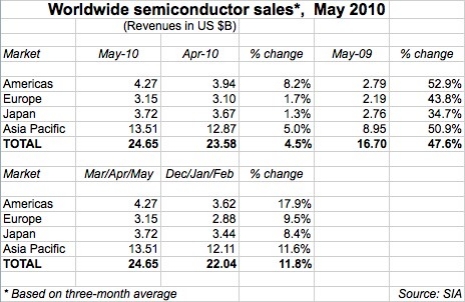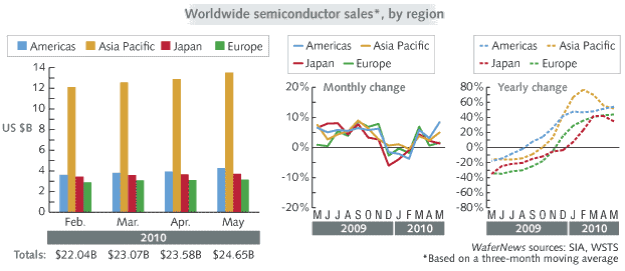(August 9, 2010) — A Europe-wide consortium has taken up the challenge of making a significant impact on the power consumption of telecommunications and data networks, which are estimated to consume as much as 3% of European electricity. Five partner organizations have come together in the BIANCHO project (BIsmide And Nitride Components for High temperature Operation), a 3-year research and development initiative supported by €2.190 million through the EU Framework 7 program.
The project will develop new semiconductor materials to allow lasers and other photonic components to become more energy efficient and also more tolerant of high operating temperatures. This power reduction is vital as optical communication systems are becoming the principal way to deliver ever-increasing data-rich broadband services to homes and businesses.
|
Follow Solid State Technology on Twitter.com via editors Pete Singer, twitter.com/PetesTweetsPW and Debra Vogler, twitter.com/dvogler_PV_semi. Or join our Facebook group |
Many current photonic components for telecommunications applications have major intrinsic losses, with around 80% of the electrical power used by a laser chip being emitted as waste heat, for example. The presence of this waste heat necessitates the use of thermo-electric coolers and an air-conditioned environment in order to control the device temperature, cascading the energy requirements by more than an order of magnitude.
The energy losses are mainly due to a process known as Auger recombination, a consequence of the band structure of the semiconductor materials used in making components such as semiconductor lasers and optical amplifiers. Over many years, incremental approaches have sought to reduce the consequent inefficiencies without addressing their fundamental cause. BIANCHO proposes a radical change of approach: to eliminate Auger recombination by manipulating the electronic band structure of the semiconductor materials through the use of novel dilute bismide and dilute nitride alloys of Gallium Arsenide and Indium Phosphide. This will allow the creation of more efficient and temperature tolerant photonic devices which could operate without the power-hungry cooling equipment that today’s networks demand.
The project brings together five leading European partners with complementary expertise in epitaxy, structural characterization of materials, device physics, band structure modelling, advanced device fabrication, packaging and commercialization. Coordinated by the Tyndall National Institute (Ireland), internationally recognized for its strength in semiconductor band structure modelling, the other academic partners are Philipps Universitaet Marburg (Germany) focussing on material growth and characterization; Semiconductor Research Institute (Lithuania) responsible for the design, manufacture and characterization of bismide-based epitaxial structures; the University of Surrey (UK) who contribute unique characterisation facilities and modelling expertise. Commercialization of the project results will be led by CIP Technologies (UK) an organization with a long history of applied photonics innovation, particularly in the telecommunications sector.
Further information:
Tyndall National Institute – www.tyndall.ie/ptg
Contact: Mary O’Regan ([email protected]) Tyndall National Institute is the largest ICT-related research institute in Ireland. Tyndall covers a broad range of research capabilities in the areas of photonics, electronics and nanotechnology as well as related technological areas such as the interface between the Life Sciences and ICT.
Philipps University Marburg – www.uni-marburg.de/wzmw/strl
Contact: Professor Kerstin Volz ([email protected])
The Material Sciences Center (WZMW) of Philipps University Marburg (UNIMAR) is an interdisciplinary research centre founded in 1988. It encompasses groups from the departments of physics, chemistry and pharmacy and is engaged with research as well as with teaching in the respective departments. The structure and technology research laboratory (http://www.uni-marburg.de/wzmw/strl) deals mainly with the growth and characterisation as well as processing of and the application of III-V semiconductor heterostructures.
University of Surrey – www.surrey.ac.uk
The University of Surrey is one of the UK’s leading professional, scientific and technological universities with a world class research profile and a reputation for excellence in teaching and research.
Center for Physical Sciences and Technology, Semiconductor Physics Institute
Contact: Professor Arunas Krotkus ([email protected]) Semiconductor Physics Institute (http://www.pfi.lt/index_e.html ) is the largest research institute dealing with semiconductor technology, material and device investigations in Lithuania and in the Baltic countries.
CIP Technologies – www.ciphotonics.com
Contact: Michael Robertson ([email protected])
CIP Technologies is the trading name of The Centre for Integrated Photonics Ltd, a world-renowned developer of advanced photonic hybrid integrated circuits and InP-based opto-electronic chips, devices, arrays and modules for the communications, defence and renewable energy markets.


 Michael A. Fury,
Michael A. Fury,
